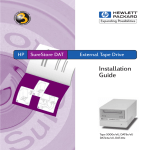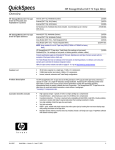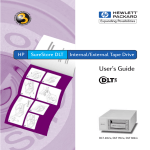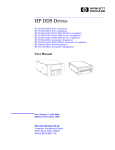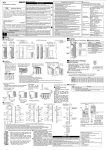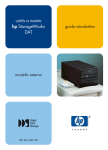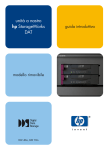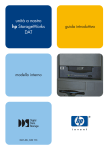Download HP SureStore DAT 40i DAT Tape Drive
Transcript
HP SureStore DAT Internal Tape Drive Installation Guide Tape 5000i, DAT8i DAT24i, DAT40i HP SureStore DAT Installation Overview (Internal Drives) Refer to: Before you start: page 1-2 Check the packing list inside this guide. Check system prerequisites. Step 1: Check the Drive’s SCSI ID page 1-6 Check the tape drive’s SCSI ID. If necessary change it from the default of 3 by setting jumpers on the back of the drive. Step 2: Set the Configuration Switches (UNIX Systems Only) page 1-10 Check the UNIX configuration switches on the bottom of the drive. Change the switch settings, if necessary. Step 3: Prepare the Mounting Bay page 1-11 Switch off the computer and remove its outer casing. Remove the cover plate from an empty, 5¼-inch, half-height bays. (Keep the screws.) If your computer has 3½ inch bays, fit the supplied 5¼ to 3½ conversion kit to the drive. Step 4: Attach Mounting Rails page 1-14 Attach any mounting hardware (rails or tray) necessary for your computer. In the box you will find mounting rails for use with HP Kayak/Vectra/Brio/NetServer E-series, a tray for use with HP NetServer L-series and mounting rails for non-HP systems. Step 5: Install the Drive page 1-16 Fit the power cable extension and slide the tape drive into the bay. To aid fitting cables, do not secure the drive with screws yet. Step 6: Attach Power and SCSI Cables page 1-17 Attach a spare power cable from the computer’s internal power supply. Attach the drive to a spare connector on the SCSI ribbon cable. Step 7: Secure the Drive page 1-19 Secure the drive in place with the provided screws. Replace the computer’s cover and reconnect cables. On Completion Power on the system and check the tape drive is operational. Insert the HP SureStore Tape CD-ROM. It contains drivers, backup software and many useful utilities. Register your tape drive. page 1-20 Overview Internal Drives—Installation Overview Dat-int.bk Page ii Wednesday, May 26, 1999 10:46 AM Copyright © 1998-1999 by Hewlett-Packard Limited. The information contained in this document is subject to change without notice. November 1999 Part Number: C1555-90909 Printed in the UK. This document contains proprietary information which is protected by copyright. All rights are reserved. No part of this document may be photocopied, reproduced or translated to another language without the prior written consent of Hewlett-Packard Limited. Hewlett-Packard shall not be liable for errors contained herein or for incidental or consequential damages (including lost profits) in connection with the furnishing, performance, or use of this material whether based on warranty, contract, or other legal theory. Windows is a U.S. registered trademark of Microsoft Corp. UNIX is a registered trademark of X/Open Company in the U.S. and other countries. Product Details Write your tape drive details here so you can find them easily if you need them. You will find the model number and serial number on the bottom of the drive. Model (type of drive): Model (number): Serial (number): Date purchased/installed: SCSI ID: Dat-int.bk Page iii Wednesday, May 26, 1999 10:46 AM Contents Internal Drives—Installation Overview inside front cover 1 Installing an “i” Model Drive (internal) Before You Start: Check the Contents of the Box 1-2 Before You Start: Check System Prerequisites 1-3 SCSI Host Adapter 1-3 SCSI Ribbon Cable 1-3 Half-Height Bay 1-4 Mounting Rails 1-4 Backup Software 1-5 Step 1: Check the Drive’s SCSI ID 1-6 Installing and Using HP TapeAssure 1-8 Step 2: Set the Configuration Switches (UNIX Systems Only) 1-10 Step 3: Prepare the Mounting Bay 1-11 Using the Conversion Kit 1-12 Step 4: Attach Mounting Rails 1-14 Step 5: Install the Drive 1-16 Step 6: Attach Power and SCSI Cables 1-17 Step 7: Secure the Drive 1-19 On Completion 1-20 Use Correct Media 1-20 Check Drive Operation 1-21 Insert the HP SureStore Tape CD-ROM 1-22 Register Your Tape Drive 1-25 Limited Warranty Statement for USA, Canada, Australia and New Zealand 1-25 2 Installation Troubleshooting Save Yourself a Call 2-2 Problems with Your Computer 2-2 Problems with Your Internal Tape Drive Other Sources of Information 2-4 HP Tape Tools 2-4 HP SureStore Tape CD-ROM 2-4 HP Web Site 2-4 2-3 iii Dat-int.bk Page iv Wednesday, May 26, 1999 10:46 AM Index Regulatory Information iv Dat-int.bk Page 1 Wednesday, May 26, 1999 10:46 AM 1 Installing an “i” Model Drive (internal) HP SureStore models covered: • Tape 5000i • DAT8i • DAT24i • DAT40i Dat-int.bk Page 2 Wednesday, May 26, 1999 10:46 AM HP SureStore DAT Installation Guide Before You Start: Check the Contents of the Box The following equipment is supplied with your HP SureStore DAT drive. ❑ HP NetServer L-series tray ❑ HP SureStore DAT drive ❑ HP SureStore Tape CD-ROM containing: • • • • • • • HP TapeAssure software TapeAlert utility Drivers Backup software HP Tape Tools Electronic User’s Guide Media and accessories information ❑ HP Vectra/ Kayak/Brio/ NetServer E-series rails ❑ Compaq rails (with DAT8i, DAT24i and DAT40i models only) ❑ Installation Guide (Please discard unneeded languages in recycling bin.) ❑ Set of four screws (+ one spare) ❑ Warranty Registration Card and label ❑ Power extension cable ❑ DDS-format data cartridge ❑ 5¼ to 3½-inch conversion kit ❑ Cleaning cartridge ❑ 50-to-68-pin adapter (not for use with DAT40 drives) If anything is damaged or missing, contact the delivery company or your supplier. Spare jumpers for the drives’ SCSI ID switch may also be supplied. 1-2 Dat-int.bk Page 3 Wednesday, May 26, 1999 10:46 AM HP SureStore DAT Installation Guide Before You Start: Check System Prerequisites To install and use your new tape drive, you will need the following: • SCSI host adapter • SCSI ribbon cable • Available 5¼-inch (or 3½-inch), half-height bay • Mounting hardware, if required • Backup software that supports the tape drive SCSI Host Adapter You need a properly installed and configured SCSI host adapter or a builtin SCSI controller on your computer’s motherboard (SCSI-2 or SCSI-3 compliant). Consult your supplier for details. If you are installing on a Windows® 95, Windows 98, Windows NT or Novell NetWare system, you can use HP TapeAssure to check your computer’s SCSI configuration, as directed on page 1-6. HP SureStore DAT Drives and SCSI All HP SureStore DAT drives, apart from the HP SureStore DAT40 are fast narrow SCSI devices and should be connected to a single-ended (SE) host bus adapter. The HP SureStore DAT40 drive is an ultra wide SCSI device. For optimum performance it should be connected to a low voltage differential (LVD) SCSI host adapter. HP SureStore DAT40 drives may also be connected to SE (single-ended) SCSI host adapters, but cable length will be restricted to the SE rather than the LVD specification. If you would like more information on SCSI specifications and configuring your SCSI bus, read the “SCSI Background” topic in the “Before You Start” section of the electronic User’s Guide on the HP SureStore Tape CD-ROM. SCSI Ribbon Cable You need a SCSI ribbon cable with the correct termination. Tape 5000, DAT8 and DAT24 drives have a 50-pin narrow SCSI connector. If your computer uses wide SCSI, use the supplied 50-to-68-pin adapter to connect the drive (50 pins) into the wide SCSI bus (68 pins). 1-3 Dat-int.bk Page 4 Wednesday, May 26, 1999 10:46 AM HP SureStore DAT Installation Guide The DAT 40 drive has a 68-pin wide, high-density SCSI connector. If your computer uses narrow SCSI, use a 68-to-50-pin adapter to connect the DAT40 drive (68 pins) into the narrow SCSI bus (50 pins). This adapter must be purchased separately (part number C7423A). See the electronic DAT Media and Orderable Accessories Guide on the HP SureStore Tape CD-ROM for ordering information. Half-Height Bay You need a 5¼-inch, half-height bay in which to install the tape drive. If you have 3½-inch bays, use the supplied 5¼ to 3½-inch conversion kit. Mounting Rails For many servers, no tray or rails are required. Devices simply slide into the computer’s chassis and are fixed with screws. Some servers require special mounting tray or rails to fix the drive into the empty bay. The drive comes with mounting hardware for HP NetServer Lseries, E-series, Kayak, Brio and Vectra computers and, for DAT8i, DAT24i and DAT40i drives only, Compaq servers. (Not all HP NetServer E-series and Compaq servers require rails.) Rails for Dell servers may be ordered separately. Different models of server require different rail kits. • Order HP accessory C5731A for Dell 2100/2200 servers • Order HP accessory C5732A for Dell 2300/4100/6100 servers • Order Dell accessory 86194 for Dell 4300/6300 servers Other computers use non-standard mounting rails and do not include spares. If this is the case with your system, you will have to order these accessories from the computer manufacturer before you can install the tape drive. 1-4 Dat-int.bk Page 5 Wednesday, May 26, 1999 10:46 AM HP SureStore DAT Installation Guide Backup Software You need backup software that supports the drive. Applications usually recognize tape drives by their manufacturers’ internal identifiers rather than their model numbers, so check the table below for the appropriate reference for your model. Drive Model Internal Identifier HP SureStore Tape 5000 HP 35480A HP SureStore DAT8 HP C1533A HP SureStore DAT24 HP C1537A HP SureStore DAT40 HP C5683A The HP SureStore Tape CD-ROM contains backup software, as well as drivers, useful utilities and information about using your tape drive. See page 1-22 for more information about using the HP SureStore Tape CD-ROM. 1-5 Dat-int.bk Page 6 Wednesday, May 26, 1999 10:46 AM HP SureStore DAT Installation Guide Step 1: Check the Drive’s SCSI ID Note Your HP SureStore DAT drive is shipped with a default SCSI ID of 3, but it can be assigned any unused ID between 0 and 6. Do not use SCSI ID 7, which is reserved for the SCSI controller, or SCSI ID 0, which is typically assigned to the boot disk. HP SureStore DAT40 drives can be assigned any unused ID between 0 and 15. Do not use SCSI ID 7 or SCSI ID 0. 1 Determine whether you need to change the SCSI ID from the default of 3. If you are installing on a Windows 95/98, Windows NT or NetWare system, install HP TapeAssure from the Software page on the HP SureStore Tape CD-ROM and run it to check your computer’s current SCSI configuration. See “Installing and Using HP TapeAssure” on page 1-8 for more information about installing and running HP TapeAssure. If you are installing on a UNIX® system, check the electronic User’s Guide on the HP SureStore Tape CD-ROM, for instructions on how to determine the SCSI IDs of existing devices. See page 1-22 for instructions on using the HP SureStore Tape CD-ROM. 2 Change the tape drive’s SCSI ID, if necessary. The SCSI ID is set using jumpers on a set of pins at the rear of the drive. Use your fingers to move the jumpers to the pattern corresponding to the ID you want. Do not remove the TERM PWR jumper. It should always be set. Spare jumpers will either be on switch itself (but only attached to a single pin) or in the accessories box. • For HP SureStore Tape 5000i, HP SureStore DAT 8i and DAT24i models, see figure 1.1. • For HP SureStore DAT40i models, see figure 1.2. Caution Static electricity can damage electronic components. To equalize the electromagnetic charges, touch a bare metal part of the computer (such as the back plate) before you remove the tape drive from its bag. 1-6 Dat-int.bk Page 7 Wednesday, May 26, 1999 10:46 AM HP SureStore DAT Installation Guide Figure 1.1 SCSI ID settings on back of HP SureStore Tape 5000i, DAT8i and DAT24i SCSI ID 1 2 3 4 5 6 (Default) 1-7 Dat-int.bk Page 8 Wednesday, May 26, 1999 10:46 AM HP SureStore DAT Installation Guide Figure 1.2 SCSI ID settings on back of HP SureStore DAT40i Example SCSI IDs 2 3 5 9 13 (Default) Installing and Using HP TapeAssure HP TapeAssure allows you to check your computer’s current SCSI configuration on a Windows or NetWare system. You cannot install HP TapeAssure on Unix systems. Installing HP TapeAssure 1 Select home.htm on the HP SureStore Tape CD-ROM and the required language. 2 Select the “HP TapeAssure” topic and follow the instructions on the screen to install HP TapeAssure. In Windows 95/98 or Windows NT, you can install HP TapeAssure directly on the system to which the tape drive is connected. In NetWare, you will need to install HP TapeAssure on the server from a client workstation running Windows 95/98 or Windows NT, and then run HP TapeAssure from the NetWare server console. 1-8 Dat-int.bk Page 9 Wednesday, May 26, 1999 10:46 AM HP SureStore DAT Installation Guide Using HP TapeAssure Note If the program does not work correctly or hangs during processing, there may be a compatibility problem with the SCSI card. The current version of HP TapeAssure may not support Adaptec 1510 cards (6360 chip set) and Symbios cards. 1 Once it is installed, run TapeAssure from the Programs menu in the Windows Start menu. HP TapeAssure will check for the presence of a SCSI controller and its driver software and identify the SCSI IDs of existing SCSI devices. 2 View the current configuration and determine whether you need to change the SCSI ID from the default of 3. 3 Exit TapeAssure after you view the SCSI configuration information. 1-9 Dat-int.bk Page 10 Wednesday, May 26, 1999 10:46 AM HP SureStore DAT Installation Guide Step 2: Set the Configuration Switches (UNIX Systems Only) 1 Check the “UNIX Configuration Instructions” in the electronic User’s Guide on the HP SureStore Tape CD-ROM for specific advice for your operating system. You will need web browser software to access the electronic User’s Guide. See page 1-22 for more information about using the HP SureStore Tape CD-ROM. The following table summarizes the typical switch settings for different types of computer, but further details are provided in the electronic User’s Guide. Switch Number 1 2 3 4 5 6 7 8 Default and most PC systems System Type On On Off On On On On On DEC systems On On Off On On On On Off HP systems (Series 700) On On Off On On On On On IBM RS/6000 systems On On Off On On Off Off On SCO/PC UNIX systems On On Off On On On On On Silicon Graphics systems On On Off On On Off Off On Sun systems On On On On On Off Off On 2 If your UNIX configuration requires it, change the configuration switches located on the underside of the drive from the default settings shown in figure 1.3. Figure 1.3 Configuration switches (shown in default positions) = ON = OFF 1-10 Dat-int.bk Page 11 Wednesday, May 26, 1999 10:46 AM HP SureStore DAT Installation Guide Step 3: Prepare the Mounting Bay Caution To avoid damaging the computer or tape drive, ensure that the computer is powered off while you install the drive. Static electricity can damage electronic components. After you have disconnected power from the computer and removed the cover, touch a bare metal part of the chassis. Similarly, touch a bare metal part of the drive before installing it. 1 Assemble the necessary tools and materials: ❑ Phillips screwdriver ❑ Flat-bladed screwdriver (if your computer uses slotted screws) ❑ Torx screwdriver (if your computer uses torx screws) ❑ Your computer manuals (for reference during installation) 2 Perform a normal system shutdown and turn off the computer and any connected peripherals. 3 Remove the cover from the computer. As you work inside the computer, you may have to disconnect the SCSI cable or power cable from other devices to maneuver the new drive into place. If you have to do this, make a note of their position and connections so you can put them back correctly later. 4 Remove the front cover plate from a spare 5¼-inch (or 3½-inch) bay of your computer. Keep any screws for use in step 7 on page 1-19. 5 If you will be installing the tape drive in a 3½-inch bay, you need to use the conversion kit as described below, so that the drive will fit into your computer. If your computer has 5¼-inch bays, proceed to step 4 on page 1-14 now. 1-11 Dat-int.bk Page 12 Wednesday, May 26, 1999 10:46 AM HP SureStore DAT Installation Guide Using the Conversion Kit 1 Unscrew the four screws and remove the rails from the tape drive. Figure 1.4 Removing the drive rails prior to installation in a 3½-inch bay 2 Use a screwdriver to release the 5¼-inch front panel from the tape drive and remove it. Fit the 3½-inch front panel and push firmly until the panel clicks into place. Figure 1.5 Removing the 5¼-inch panel Note: Some drives have clips on the sides of the unit. 1-12 Dat-int.bk Page 13 Wednesday, May 26, 1999 10:46 AM HP SureStore DAT Installation Guide 3 Fit the 3½-inch front panel and push firmly until the panel clicks into place. Figure 1.6 Fitting the 3½-inch panel Clips on top of tape drive Clips on side of tape drive 1-13 Dat-int.bk Page 14 Wednesday, May 26, 1999 10:46 AM HP SureStore DAT Installation Guide Step 4: Attach Mounting Rails If your computer requires special rails or other hardware to install the tape drive, mount them on the tape drive in this step. If your computer does not require special mounting hardware, proceed to step 5 on page 1-16 now. 1 Attach the appropriate rails. • If you are installing in an HP NetServer L-series, place the tape drive in the mounting tray supplied, as shown in figure 1.7. • If you are installing in an HP NetServer E-series that requires mounting rails, Vectra, Kayak or Brio, fasten the rails to the tape drive using the four screws supplied, as shown in figure 1.8. • If you are installing in a Compaq computer that requires mounting rails, fasten the rails to the tape drive using the four screws supplied, as shown in figure 1.9. Compaq rails are provided with DAT8i, DAT24i and DAT40i models only. • If you are installing in a IBM or Dell computer, refer to our World Wide Web site for further instructions: http://www.hp.com/go/connect. • If your computer uses other mounting hardware, attach it to the tape drive as directed in your computer documentation. 2 Secure the tape drive in the mounting tray using the four screws supplied with the rail kit. Figure 1.7 Attaching the tape drive to the HP NetServer L-series mounting tray Use the four screws provided with the rail kit 1-14 Dat-int.bk Page 15 Wednesday, May 26, 1999 10:46 AM HP SureStore DAT Installation Guide Figure 1.8 Attaching the HP NetServer E-series, Vectra, Kayak or Brio rails to the tape drive Use the four screws provided with the rail kit Figure 1.9 Attaching Compaq rails to the tape drive Use the four screws provided with the rail kit 1-15 Dat-int.bk Page 16 Wednesday, May 26, 1999 10:46 AM HP SureStore DAT Installation Guide Step 5: Install the Drive Note Write the model name, product number, serial number, and SCSI ID of your drive in the front of this guide for future reference. The model name is on the front of the drive and the product and serial numbers are on a label on the bottom of the drive. 1 Attach the power cable extension to the rear of the tape drive, as shown in figure 1.10. Figure 1.10 Attaching the power cable extension 2 Slide the tape drive into the open bay, aligning the tray or rails with the slots in the bay, as shown in figure 1.11. If your computer does not use mounting hardware, check that the holes in the chassis are aligned with the holes in the side of the tape drive. Do not secure the drive with screws at this point because you may have to move the drive to get the cables into place. 1-16 Dat-int.bk Page 17 Wednesday, May 26, 1999 10:46 AM HP SureStore DAT Installation Guide Figure 1.11 Sliding the tape drive into the empty bay Step 6: Attach Power and SCSI Cables 1 Attach a spare power cable from the computer’s internal power supply to the power extension cable, as shown in figure 1.12. Figure 1.12 Attaching the power cable and SCSI cable SCSI ribbon cable Power cable 1-17 Dat-int.bk Page 18 Wednesday, May 26, 1999 10:46 AM HP SureStore DAT Installation Guide 2 Attach a spare SCSI cable to the SCSI connector. If you are using an existing SCSI cable, simply attach the drive to a spare connector on the computer’s SCSI ribbon cable, as shown in figure 1.12. DAT8i and DAT24i drives only: If your computer has wide SCSI, use the supplied 50-to-68-pin adapter to connect the tape drive to the SCSI bus. Plug the adapter into the 68-pin SCSI connector on the computer and then connect the SCSI cable from the adapter to the 50-pin SCSI connector on the tape drive. If you are using a new SCSI cable, attach the end farthest from the terminator block to the computer’s internal SCSI connector, as shown in figure 1.13, and attach one of the connectors to the tape drive. Figure 1.13 Attaching the SCSI ribbon cable Terminator block Tape drive SCSI ribbon cable SCSI connection 1-18 Dat-int.bk Page 19 Wednesday, May 26, 1999 10:46 AM HP SureStore DAT Installation Guide Step 7: Secure the Drive 1 Secure the tape drive into place with screws. If you used mounting hardware that screws to the front of the computer, use the screws you removed in step 3 to fix the drive in place. If your computer does not require mounting hardware, check that the holes in the chassis are aligned with the holes in the sides of the drive and use the four screws provided with the rail kit to secure the drive, as shown in figure 1.14. Figure 1.14 Securing the drive into a typical PC chassis without the use of mounting rails Use four screws to secure the drive 2 Replace the cover on the computer. 1-19 Dat-int.bk Page 20 Wednesday, May 26, 1999 10:46 AM HP SureStore DAT Installation Guide On Completion Once you have completed the installation: • Make sure you have the correct media. • Power on and check that your new drive is operational. • Insert the HP SureStore Tape CD-ROM. It contains everything you will need to use your tape drive—drivers, backup software, utilities and user information. • Register your tape drive to ensure that you benefit from the full 3-year warranty period. Use Correct Media For optimum performance and storage capacity, use tape cartridges that match your drive's format, and normally use only one cartridge per day. • HP SureStore DAT40 drives work best with DDS-4 cartridges. • HP SureStore DAT24 drives work best with DDS-3 cartridges. • HP SureStore DAT8 drives work best with DDS-2 cartridges. • HP SureStore Tape 5000 drives use only DDS-1 cartridges (60-meter or 90-meter). However, most HP SureStore DAT drives are fully backward compatible (apart from the HP SureStore DAT40). The compatibility between drive models and cartridges is summarized in the following table. Shaded boxes show the recommended media for each tape drive. HP SureStore Tape 5000 DDS-1 60 meter DDS-1 90 meter 2.6 GB* 4 GB* DDS-2 120 meter DDS-3 125 meter HP SureStore DAT8 read/write read/write 8 GB* HP SureStore DAT24 read/write read/write read/write 24 GB* read only read/write read/write HP SureStore DAT40 * Capacity assumes 2:1 compression. 1-20 DDS-4 150 meter 40 GB* Dat-int.bk Page 21 Wednesday, May 26, 1999 10:46 AM HP SureStore DAT Installation Guide Check Drive Operation 1 Switch on the computer. The tape drive will run its hardware self-test, which takes about 5 seconds. At the end of the hardware self-test, both front panel lights should be off. Read more about the self-test and front panel lights in the electronic User’s Guide on the HP SureStore Tape CD-ROM. 2 Verify that the tape drive installation was successful. For Windows and NetWare systems, select HP TapeAssure from the Windows Start menu. (If you did not install HP TapeAssure at the start of the installation process, install it now as described on page 1-8.) No other backup software should be running at the same time. For UNIX systems, the configuration instructions in the electronic User’s Guide on the HP SureStore Tape CD-ROM include a verification procedure. Note If you encounter a problem during this verification procedure, turn to “Save Yourself a Call” on page 2-2 for help in diagnosing and fixing the problem. 3 Install backup software, as required (see page 1-23). Use a blank cartridge to carry out the backup and restore test, which you should perform to check that the drive can write data to tape. To load a cartridge: Open the door flap, if fitted. Insert the cartridge into the slot in front of the drive with the label uppermost and apply gentle pressure until the drive takes the cartridge and loads it. The Tape light flashes green while the drive performs its load sequence. When the cartridge is loaded, the Tape light shows steady green. To unload a cartridge: Press the Unload button on the front panel. The drive completes any task it is currently performing, winds the tape to the beginning, and ejects the cartridge. The sequence will take about 25 seconds for a write-enabled cartridge and 10 seconds for a write-protected cartridge. Unload button 1-21 Dat-int.bk Page 22 Wednesday, May 26, 1999 10:46 AM HP SureStore DAT Installation Guide Insert the HP SureStore Tape CD-ROM The HP SureStore Tape CD-ROM contains backup software, as well as drivers, useful utilities and information about using your tape drive. 1 Load the CD-ROM and select home.htm. Note If you do not have a web browser, see the Readme.txt file. 2 Select the required language to display the Welcome page. You may like to add this page to your Bookmarks/Favorites for easy, subsequent access to items on the HP SureStore Tape CD-ROM. 3 Select the appropriate link from the Welcome page. You will find backup software and drivers under the “Software” topic, and electronic User’s Guides, frequently asked questions and ordering information under the “User Documentation” topic. Note for UNIX Users With some UNIX systems you may have problems reading the HTML files. When you mount the CD-ROM, if the file names have a version number and are all in capitals (for example, README.TXT;1), use the cdcopy.sh utility that you can find in the UNIX directory on the CD-ROM. This utility ensures that all file names and links work correctly in the HTML pages. Run the command as follows: cdcopy.sh /mnt /toplevel where /mnt is the CD mount point and /toplevel is a new directory in which the files will be created. Drivers For detailed information about drivers, refer to the appropriate README file in the DRIVERS directory on the HP SureStore Tape CD-ROM. There is a separate sub-directory for each operating system. The tape drive must be installed before installing the driver. 1-22 Dat-int.bk Page 23 Wednesday, May 26, 1999 10:46 AM HP SureStore DAT Installation Guide Backup Software To use the tape drive, you will need a backup application or utility that supports your tape drive model. The HP SureStore Tape CD-ROM contains free backup software for use with Windows 95, Windows 98, Windows NT and Novell NetWare. This software also provides full support for HP One-Button Disaster Recovery, which allows complete system recovery at the touch of a button using only the latest backup cartridge. Note Not all system configurations and backup software are capable of supporting HP One-Button Disaster Recovery. • If you are installing the drive on a standalone PC or a client PC that runs Windows 95/98, you can use the HP Colorado Backup II software. • If you are installing the drive on a PC that runs Windows NT Server or Novell Netware, you can use Replica Single Server for HP SureStore Tape. If using Replica with NetWare, please see the README file on the HP SureStore Tape CD-ROM. Replica is not supported on NetWare 5.0. • The tape drive must be installed before installing the software. For the latest list of backup packages that support HP SureStore DAT drives and advanced features such as HP One-Button Disaster Recovery and TapeAlert, refer to our World Wide Web site (http:// www.hp.com/go/connect). The Selection section of this web site lists backup software solutions suitable for your tape drive model and operating system (including Microsoft Windows, Novell NetWare, IBM OS/2, various UNIX systems, and Apple Macintosh). Note Once you have installed your backup software, remember to carry out a trial backup and restore. User Documentation For more information about using your DAT drive, refer to the “User Documentation” topic on the HP SureStore Tape CD-ROM. This provides links to frequently asked questions about drivers and operating systems, and, from the “DAT Drive Documentation” link, to three electronic User’s Guides: • HP SureStore DAT User’s Guide • HP One-Button Disaster Recovery Guide • Media and Orderable Accessories Guide 1-23 Dat-int.bk Page 24 Wednesday, May 26, 1999 10:46 AM HP SureStore DAT Installation Guide Refer to your backup application’s documentation for instructions on how to back up and restore data. Viewing the Electronic User’s Guides You can view the electronic User’s Guides with most current web browsers on any platform. To view all the features of the electronic User’s Guide, including color and animation, your system will need: • A CD-ROM drive • A super-VGA monitor configured to display at least 256 colors HP SureStore DAT User’s Guide This guide contains: • Features and specifications of HP SureStore DAT drive models • Operating instructions and how to interpret the front panel lights • Which tape cartridges to use and how to store them safely • Tape drive maintenance instructions • Customer support information, such as warranty details, how to get service, and how to contact technical support • How to order parts and accessories • UNIX configuration instructions • Advice on backup strategies and SCSI bus configuration HP One-Button Disaster Recovery User’s Guide This guide contains: • Instructions on using HP One-Button Disaster Recovery • Compatibility and troubleshooting advice Media and Orderable Accessories Guide This guide contains: • Recommended media for your tape drive • Details about orderable accessories 1-24 Dat-int.bk Page 25 Wednesday, May 26, 1999 10:46 AM HP SureStore DAT Installation Guide Register Your Tape Drive You must register with HP to ensure that you benefit from the full 3-year Express Exchange1 warranty period. The second and third years of warranty are subject to registration within 30 days. Please register via the web (http://www.hp.com/go/tapereg) or by using the reply card in the box. The first year of warranty is provided automatically. In order to ensure your registration is complete, there are a number of questions on the registration card and electronic form that are mandatory. Other questions are optional. However, the more you feel able to complete, the better HP can meet your needs. (If you wish, you may register your drive and choose NOT to receive any further information from HP.) If you have internet access, register electronically as described below. 1 Select the “Warranty Registration” topic on the HP SureStore Tape CD-ROM. 2 Select the “Register on the Web” link. This links you to HP’s Warranty Registration web site. 3 Complete the registration form. Mandatory questions are shown in red text. 4 Click on the Submit button to forward your registration immediately to HP. If you do not have internet access: 1 Complete the Warranty Registration card supplied with the drive. Mandatory questions are in black, bold text. 2 Post or fax the completed form to HP. Limited Warranty Statement for USA, Canada, Australia and New Zealand 1 HP warrants to you, the end-user customer, that HP hardware, accessories and supplies will be free from defects in materials and workmanship after the date of purchase, for the period specified above. If HP receives notice of such defects during the warranty period, HP will, at its option, either repair or replace products which prove to be defective. Replacement products may be either new or like-new. 1. Express Exchange is available in most countries. In those countries that do not currently support Express Exchange, support is provided through either the Low End Support Program or the local parts center. Years 2 and 3 are subject to Product Registration. 1-25 Dat-int.bk Page 26 Wednesday, May 26, 1999 10:46 AM HP SureStore DAT Installation Guide 2 HP warrants to you that HP software will not fail to execute its programming instructions after the date of purchase, for the period specified above, due to defects in material and workmanship when properly installed and used. If HP receives notice of such defects during the warranty period, HP will replace software media which does not execute its programming instructions due to such defects. 3 HP does not warrant that the operation of HP products will be uninterrupted or error free. If HP is unable, within a reasonable time, to repair or replace any product to a condition as warranted, you will be entitled to a refund of the purchase price upon prompt return of the product. 4 HP products may contain remanufactured parts equivalent to new in performance or may have been subject to incidental use. 5 Warranty does not apply to defects resulting from (a) improper or inadequate maintenance or calibration, (b) software, interfacing, parts or supplies not supplied by HP, (c) unauthorized modification or misuse, (d) operation outside of the published environmental specifications for the product, or (e) improper site preparation or maintenance. 6 HP MAKES NO OTHER EXPRESS WARRANTY OR CONDITION WHETHER WRITTEN OR ORAL. TO THE EXTENT ALLOWED BY LOCAL LAW, ANY IMPLIED WARRANTY OR CONDITION OF MERCHANTABILITY, SATISFACTORY QUALITY, OR FITNESS FOR A PARTICULAR PURPOSE IS LIMITED TO THE DURATION OF THE EXPRESS WARRANTY SET FORTH ABOVE. Some countries, states or provinces do not allow limitations on the duration of an implied warranty, so the above limitation or exclusion might not apply to you. This warranty gives you specific legal rights and you might also have other rights that vary from country to country, state to state, or province to province. 7 TO THE EXTENT ALLOWED BY LOCAL LAW, THE REMEDIES IN THIS WARRANTY STATEMENT ARE YOUR SOLE AND EXCLUSIVE REMEDIES. EXCEPT AS INDICATED ABOVE, IN NO EVENT WILL HP OR ITS SUPPLIERS BE LIABLE FOR LOSS OF DATA OR FOR DIRECT, SPECIAL, INCIDENTAL, CONSEQUENTIAL (INCLUDING LOST PROFIT OR DATA), OR OTHER DAMAGE, WHETHER BASED IN CONTRACT, TORT, OR OTHERWISE. Some countries, states or provinces do not allow the exclusion or limitation of incidental or consequential damages, so the above limitation or exclusion may not apply to you. FOR CONSUMER TRANSACTIONS IN AUSTRALIA AND NEW ZEALAND: THE WARRANTY TERMS CONTAINED IN THIS STATEMENT, EXCEPT TO THE EXTENT LAWFULLY PERMITTED, DO NOT EXCLUDE, RESTRICT OR MODIFY AND ARE IN ADDITION TO THE MANDATORY STATUTORY RIGHTS APPLICABLE TO THE SALE OF THIS PRODUCT TO YOU. Consumer Warranty Sept 16/97 1-26 Dat-int.bk Page 1 Wednesday, May 26, 1999 10:46 AM 2 Installation Troubleshooting Dat-int.bk Page 2 Wednesday, May 26, 1999 10:46 AM HP SureStore DAT Installation Troubleshooting Save Yourself a Call The first step in problem-solving is establishing whether the problem lies with the cartridge, the tape drive, the host computer and its connections, or with the way the system is being operated. If none of the following advice helps you solve the problem, call for service. The HP technical support numbers are listed in the “Customer Support” topic in the electronic User’s Guide on the HP SureStore Tape CD-ROM. Problems with Your Computer Problem The computer does not boot up. The computer boots but then hangs. Possible Cause Refer to your host adapter documentation to check that the adapter is configured correctly. You may have disconnected the power or SCSI cable from the computer’s boot disk during the tape drive installation process. Check that the cables to all devices are firmly connected. This might be caused by conflicts in your hardware or software configuration, such as two devices with the same SCSI ID or improper termination of the SCSI bus. Make sure that each device connected to the SCSI controller has a unique SCSI ID. Check that the SCSI bus is actively terminated. (The electronic User’s Guide on the HP SureStore Tape CD-ROM provides information on configuring your SCSI bus. Also refer to the documentation for your SCSI controller and any other SCSI devices you may have.) The computer does not The power cable or SCSI cable recognize the tape drive. may not be connected properly. 2-2 Potential Solution If you have just installed a SCSI host adapter card in your computer and the computer did not boot up when you switched it on, the new adapter is the likely cause of the problem. Make sure that the power cable and SCSI cable are firmly connected. Dat-int.bk Page 3 Wednesday, May 26, 1999 10:46 AM HP SureStore DAT Installation Troubleshooting Problems with Your Internal Tape Drive Problem Possible Cause The tape drive does not The power cable may not be power up. connected to the tape drive properly. TapeAssure does not The power cable or SCSI cable recognize the tape drive. may not be connected properly. You cannot back up or restore. The SCSI connection may be loose. Potential Solution Make sure that the power cable is firmly connected. If it is, the device has probably failed. Call for service. Make sure that the power cable and SCSI cables are firmly connected. Check that all expansion boards are fully seated and the SCSI cable is connected properly. Run TapeAssure to determine whether the SCSI controller is functioning properly. The SCSI bus may not be properly Check that the SCSI terminator is terminated. installed and secure. The SCSI bus must be terminated at both ends. Most internal cables will have a terminator plug on the end of the cable farthest from the SCSI controller. If there are no external devices, the SCSI bus must be terminated on the SCSI host adapter or motherboard. If there are external devices, the last device in the external chain must be terminated properly. The Media Caution (Clean) light shows steady amber. The tape drive’s SCSI ID may conflict with another device. Make sure that the tape drive SCSI ID is not the same as that of any other device attached to the same SCSI controller. You can run TapeAssure to check the SCSI IDs of attached devices. This is the error condition signal. There may be a hard error on the tape drive. Try powering the system off and then on again. If the error condition signal still shows, call for service. 2-3 Dat-int.bk Page 4 Wednesday, May 26, 1999 10:46 AM HP SureStore DAT Installation Troubleshooting Other Sources of Information If you experience problems using your tape drive after installation, use HP Tape Tools to help you diagnose the problem. You will also find troubleshooting information on the HP SureStore Tape CD-ROM and the HP web site. HP Tape Tools HP Tape Tools software provides the following functionality: • Drive Information Utilities that provide you with information about your tape drive and system configuration. • Troubleshooting Diagnostics that allow you to run different tests on your tape drive to identify problems with your tape drive or media. • A Firmware Upgrade Utility that helps you find upgrade files for your tape drive and allows you to perform the upgrade. • HP Customer Support that gives you all the information you will require should you need to contact us. HP Tape Tools does not work on all operating systems. Refer to the HP SureStore Tape CD-ROM for the latest compatibility information. HP SureStore Tape CD-ROM The HP SureStore Tape CD-ROM contains: • Troubleshooting information in the electronic User’s Guide (this is operational rather than installation troubleshooting) • Frequently asked questions when using tape drives on Windows NT, NetWare or Unix operating systems ❑ Select the “User Documentation” topic on the Welcome page and follow the appropriate links. See page 1-22 for more information about using the HP SureStore Tape CD-ROM. HP Web Site The HP support web site contains two useful links: • http:/www.hp.com/support/dat takes you to HP’s Customer Care web site for a wide range of up-to-date information about your product • http://www.hp.com/support/dds_troubleshooting takes you directly to the Customer Care troubleshooting pages 2-4 Index A accessories, ordering See electronic User’s Guide anti-static protection 1-6 applications, backup 1-5, 1-23 B backup applications drives supported 1-5 installing 1-23 backup fails 2-3 backup strategies See electronic User’s Guide boot-up fails 2-2 browsers 1-10, 1-24 C cables, SCSI See SCSI cables 1-3 capacity, tape See electronic User’s Guide cartridge choosing See electronic User’s Guide forcing ejection See electronic User’s Guide loading 1-21 ordering See electronic User’s Guide storing See electronic User’s Guide unloading 1-21 write-protection See electronic User’s Guide CD-ROM contents 1-2 changing SCSI ID 1-6 Clean light 2-3 See also electronic User’s Guide cleaning instructions See electronic User’s Guide Colorado Backup 1-23 Compaq servers, mounting hardware 1-4 computer does not boot up 2-2 configuration switches 1-10 contacting HP See electronic User’s Guide contents of box 1-2 conversion kit, fitting 1-12 customer support. See electronic User’s Guide D data cartridge See cartridge data compression See electronic User’s Guide DDS formats supported See electronic User’s Guide default SCSI ID 1-6 Dell servers, mounting hardware 1-4 disaster recovery 1-23 drive cannot back up or restore 2-3 does not power up 2-3 maintenance See electronic User’s Guide E ejecting a cartridge 1-21 electrical cable 1-17 electrostatic discharge 1-6, 1-11 EMC certifications See back of book equipment supplied 1-2 Express Exchange Warranty See electronic User’s Guide F forcing ejection See electronic User’s Guide front panel lights See also electronic User’s Guide H hang during boot-up 2-2 head cleaning See electronic User’s Guide host adapter See SCSI controller HP NetServer attaching mounting hardware 1-14 mounting hardware 1-4 HP One-Button Disaster Recovery 1-23 HP part numbers See electronic User’s Guide HP SureStore Tape CD-ROM contents 1-2 TapeAssure 1-6, 1-8, 1-21 HP Tape Tools 2-4 I inserting a cartridge 1-21 installation fitting conversion kit 1-12 prerequisites 1-3 problems 2-2 J jumpers, SCSI ID 1-6 L LEDs See lights lights See also electronic User’s Guide Clean light 2-3 self-test 1-21 Tape light 1-21 loading a cartridge 1-21 loose connections 2-3 M maintenance instructions See electronic User’s Guide materials included 1-2 mounting hardware attaching 1-14 supplied 1-4 N narrow SCSI 1-3, 1-4 NetServer See HP NetServer non-standard mounting rails 1-4 Index-1 Novell NetWare backup applications 1-23 TapeAssure 1-9 O operating instructions See electronic User’s Guide ordering parts and accessories See electronic User’s Guide P parts included 1-2 power cable, attaching 1-17 power-up failure 2-3 precautions against static 1-6, 111 problems SCSI termination 2-3 with computer 2-2 with tape drive 2-3 putting in a cartridge 1-21 R radio interference statements See back of book rails attaching 1-14 non-standard 1-4 supplied 1-4 read-write test 1-21 regulatory information See back of book removing a cartridge 1-21 repairs See electronic User’s Guide resolving problems 2-2 restore fails 2-3 S safety certifications See back of book scheduling backups See electronic User’s Guide SCSI checking configuration 1-8 configuration See electronic User’s Guide connection loose 2-3 installation prerequisites 1-3 SCSI internal connector 1-18 LVD devices 1-3 narrow SCSI 1-3, 1-4 SE devices 1-3 termination 1-18 termination problems 2-2, Tape light 1-21 See also electronic User’s Guide TapeAlert See electronic User’s Guide TapeAssure checking configuration 1-8, 1- 2-3 wide SCSI 1-3, 1-4 SCSI bus configuration See electronic User’s Guide SCSI cable required for drive 1-3 SCSI controller problems with 2-2 required for installation 1-3 SCSI ID checking existing devices 1-9 conflicting 2-3 default 1-6 devices sharing 2-2 setting 1-6 self-test 1-21 service See electronic User’s Guide setting SCSI ID 1-6 software backup 1-5, 1-23 installing 1-23 specifications, drive See electronic User’s Guide static protection 1-6, 1-11 support numbers See electronic User’s Guide T tape cartridge See cartridge tape drive cannot back up or restore 2-3 does not power up 2-3 maintenance See electronic User’s Guide tape formats See electronic User’s Guide tape heads, cleaning See electronic User’s Guide tape life See electronic User’s Guide 21 purpose 1-3, 1-21 verifying installation 1-21 technical support See electronic User’s Guide telephone numbers See electronic User’s Guide termination problems 2-3 termination, SCSI See electronic User’s Guide terminator block 1-18 testing installation 1-21 tray, attaching 1-14 troubleshooting 2-2 U ultra wide SCSI 1-3 UNIX systems See also electronic User’s Guide backup applications 1-23 configuration switches 1-10 Unload button 1-21 unloading a cartridge 1-21 unpacking list 1-2 unpacking precautions 1-6, 1-11 usage instructions See electronic User’s Guide V verifying installation 1-21 W Warranty Registration 1-25 warranty See electronic User’s Guide web browsers 1-10, 1-24 wide SCSI 1-3, 1-4 Windows systems 1-23 World Wide Web site 1-23 write-protection See electronic User’s Guide Index-2 Dat-int.bk Page 5 Wednesday, May 26, 1999 10:46 AM Regulatory Information Europe TUV (Internal Tape Drives Only) Declaration of Conformity (according to ISO/IEC Guide 22 and EN 45014) Manufacturer: Hewlett-Packard Company Address: Hewlett-Packard Company Computer Peripherals Bristol Filton Road Stoke Gifford Bristol BS34 8QZ United Kingdom declares that the following products Product Name: HP SureStore Tape 5000i HP SureStore DAT8i HP SureStore DAT24i HP SureStore DAT40i conform to the following product specifications Safety: IEC 950:1991+A1,A2 EN 60950 (1992)+A1,A2 EMC: CISPR 22:1993/EN 55022 (1994) EN50082-1:1992 IEC 801-2:1991/prEN 55024-2 (1992): 4kV CD, 8kV AD IEC 801-3:1984/prEN 55024-3 (1991): 3V/m IEC 801-4:1988/prEN 55024-4 (1992): 0.5 kV signal lines, 1.0kV power lines LED Emission Level This equipment must be supplied by a SafetyExtra-Low-Voltage (secondary circuit in accordance with DIN VDE 0805. During incorporation of the equipment, all requirements of DIN VDE 0805 must be observed and obeyed. General Approval NS/G/1234/J/100003 This Hewlett-Packard tape drive meets the General Approval NS/G/1234/J/100003 requirements. U.S.A. Notice (Internal Tape Drives Only) For use only in UL® listed personal computers. Canada Canadian Standards Association Information Statement (Internal Tape Drives Only) INSTRUCTION TO USER: WARNING: This component is only considered to be approved when installed in CSA certified equipment evaluated to the standards C22.2 No. 220-M1986 or C22.2 No. 950-M89. The operator accessibility into the end use enclosure is defined with strict accordance in the operator’s manual for the installation of components into the equipment. INSTRUCTIONS AUX UTILISATEURS: This equipment has been tested and found to comply with the limits for a Class 1 LED product, set out in the international standard for safety of laser products. AVERTISSEMENT : Ce composant n’est considéré agréé que s’il est installé dans un équipement certifié CSA selon les normes C22.2 No. 220-M1986 ou C22.2 No. 950-M89. L’accessibilité de l’opérateur à l’enceinte est définie en stricte conformité avec le manuel de l’opérateur pour l’installation de composants dans l’équipement.






































